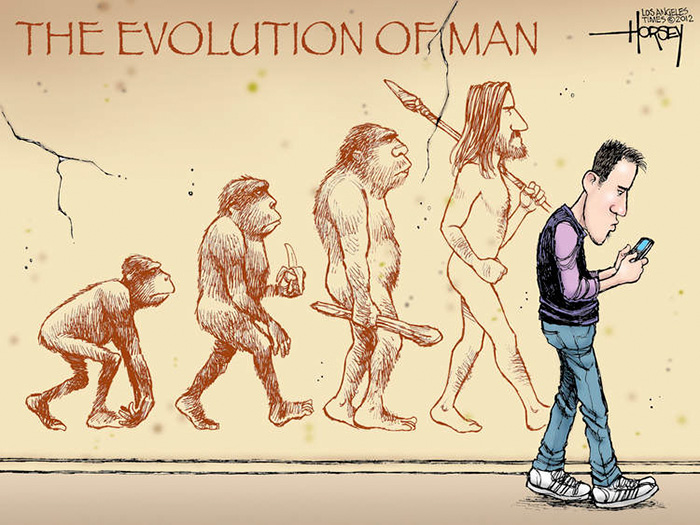From sperm counts to life expectancy, a look at recent human evolution

Illustration by David Horsey via the Los Angeles Times.
It can be hard to fathom just how much our society — and our lives — have changed in the last 50 years.
Just half a century ago, we were getting the first pocket calculators, colour television was becoming all the rage, and video games could finally be played at home. Now, I have to force myself not to spend too much time staring at the infinite information available at all times in my pocket.
But it hasn’t just been our technology, fashion, and thinking that has changed — we have. Our physiology and the key indicators of healthiness have changed in the last 50 years. Here are some of the most interesting ways in which we’ve changed, for better or for worse.
Life expectancy
The global average for life expectancy in 1974 was about 58 years. It is currently about 73 years. This can be a tricky statistic to accurately measure, but no matter the uncertainty, a 15-year jump over 50 years is pretty impressive, and could be due to great advances in healthcare, disease response, and overall living standards.
Though life expectancy is still increasing, it has dipped in many countries recently due to the effects of the COVID-19 pandemic. Additionally, life expectancy for women is considerably higher than for men, which doesn’t seem like it’ll change anytime soon.
Size
People are not only living longer, but also getting bigger, in both dimensions. Canadians have gotten slightly taller in the last 50 years, but not by much compared to the growth seen in other countries.
On the flip side, obesity rates in Canada have more than doubled since 1978, from 13.8 per cent to about 30 per cent. It is worth noting that these stats do use Body Mass Index (BMI) as their metric for obesity, which simply looks at height vs weight, not health overall. One side effect that can come from obesity is infertility.
Sperm counts
Chances are that sperm counts don’t often come up in conversations with your friends or roommates, but over the last 50 years, they have drastically dropped.
A meta-analysis of over 200 studies shows that in 1973, sperm counts were at 101 million per milliliter of semen. Compared to the 2018 count, which was 49 million per milliliter, that’s more than a 50 per cent decline. Not only that, but it says that the decline is accelerating globally.
The Mayo Clinic says that a sperm count of less than 15 million per milliliter can cause fertility problems. Is this downward trend in our little swimmers a threat to reproduction and population?
Population
Back in 1974, the world’s population was just about to break four billion. On Nov. 15, 2022, we hit the big milestone of eight billion people globally. Doubling our population in under 50 years is pretty incredible. No wonder there’s a housing crisis.
Looking more locally, Canada’s population in 1974 is estimated to have been nearly 23 million. In October 2023, it was estimated to be just over 40 million. Additionally, the rise in population from the previous quarter was 1.1 per cent, the largest increase in Canada since 1957.
India recently surpassed China in population numbers, with each country having over 1.4 billion people. The United Nations (UN) predicts that our global population will peak in the 2080s, with 10.4 billion people.
Puberty
Another stat that you’ve probably never thought about. But yes, people — especially females — are going through puberty earlier than before.
One meta-analysis found that from 1977 to 2013, the average age for the onset of puberty decreased by three months every decade.
Although improved childhood nutrition is one reason for this, stress, especially familial, is also a factor. Unfortunately, early onset puberty can result in higher risks of breast and uterine cancer later in life.
Testosterone
Have you ever seen a photo of your older male relatives from when they were younger and thought “Damn, why were they so jacked?” Well, maybe they were just eating better and exercising more, or maybe they had substantially more testosterone than you do now.
Even accounting for factors that affect testosterone levels, like rising obesity rates and falling smoking rates, testosterone levels in men have been declining for a long time. Additionally, due to increased advertising efforts, Testosterone Replacement Therapy has seen a large jump in popularity. Testosterone is important to ensure that your muscles and bones stay strong, and plays a key role in regulating libido.
These are just a few of the ways the human race has changed in the last 50 years. Who knows what we will be like in another 50 years?








